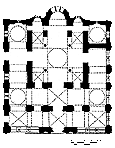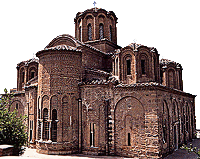 |
|
 |
Architecture
 The elegant and graceful proportions, which allow monuments to incorporate themselves felicitously into the natural environment,
The elegant and graceful proportions, which allow monuments to incorporate themselves felicitously into the natural environment,
 and the search for a chromatic and decorative harmony in their exterior aspect, constitute the main features of the particular architectural style of the Late Byzantine period. The most important and characteristic examples of Palaiologan architecture are found in Thessalonike and in Mistra, the capital city of the despotate of the Morea. In Thessalonike, the first half of the 14th century is a time of intense building activity. What particularly characterises its monuments, as can be seen in the churches of the Holy Apostles, of St Catherine, St Panteleemon and others, is the exclusive use of bricks in the upper part, the preference given to the type of the and the search for a chromatic and decorative harmony in their exterior aspect, constitute the main features of the particular architectural style of the Late Byzantine period. The most important and characteristic examples of Palaiologan architecture are found in Thessalonike and in Mistra, the capital city of the despotate of the Morea. In Thessalonike, the first half of the 14th century is a time of intense building activity. What particularly characterises its monuments, as can be seen in the churches of the Holy Apostles, of St Catherine, St Panteleemon and others, is the exclusive use of bricks in the upper part, the preference given to the type of the
 cross-in-square church
with a
peristyle
and the very definite stress on the decorative aspect of the outer facades, which are embellished with
blind arcades,
small
niches
and elaborate
brick patterns, created by placing
ordinary bricks in an infinite variety of ways to form meanders,
herringbone designs and others. These features place the monuments of
Thessalonike in the line of the architectural tradition of the
Constantinoplitan school. The monuments of Mistra, on the other hand, are
characterised by the combination of architectural elements of the Helladic
school - of mainland Greece, that is - with elements of the school of
Constantinople, to which are added local devices and elements of Western
origin. Here, a new architectural type is devised: the composite type of
church, which is a combination of the
three-aisled basilica
on the ground floor and the cross-in-square plan in the gallery. At the same time are used the earlier types prevailing in the Helladic school, such as the
domed octagon
of Epiros and the cross-in-square church with two columns. The external conformation of the walls using bricks and stones, in accordance with the cloisonne system of masonry, which is a characteristic feature of the Helladic school, is combined with blind arcades and brick decorative patterns -
reticulated patterns,
dentil courses etc. -
which differ from those encountered in the churches of Thessalonike.
cross-in-square church
with a
peristyle
and the very definite stress on the decorative aspect of the outer facades, which are embellished with
blind arcades,
small
niches
and elaborate
brick patterns, created by placing
ordinary bricks in an infinite variety of ways to form meanders,
herringbone designs and others. These features place the monuments of
Thessalonike in the line of the architectural tradition of the
Constantinoplitan school. The monuments of Mistra, on the other hand, are
characterised by the combination of architectural elements of the Helladic
school - of mainland Greece, that is - with elements of the school of
Constantinople, to which are added local devices and elements of Western
origin. Here, a new architectural type is devised: the composite type of
church, which is a combination of the
three-aisled basilica
on the ground floor and the cross-in-square plan in the gallery. At the same time are used the earlier types prevailing in the Helladic school, such as the
domed octagon
of Epiros and the cross-in-square church with two columns. The external conformation of the walls using bricks and stones, in accordance with the cloisonne system of masonry, which is a characteristic feature of the Helladic school, is combined with blind arcades and brick decorative patterns -
reticulated patterns,
dentil courses etc. -
which differ from those encountered in the churches of Thessalonike.
See also : The School of Constantinople
|